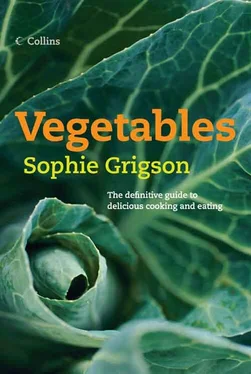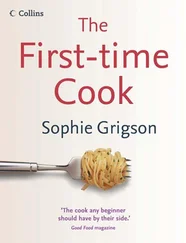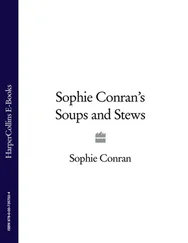This is a terrific supper dish. Ham and parsnip are happy bedfellows, but need a good dose of spiky mustard in the sauce to bring them to life.
Serves 4
8 wee parsnips, or 4 big chunky parsnips
15g (1/2 oz) butter
8 slices very nice cooked ham indeed
30g (1 oz) Parmesan, freshly grated
Sauce
30g (1 oz) butter
30g (1 oz) plain flour
600 ml (1 pint) milk
2 tablespoons coarse-grain or Dijon mustard
salt, pepper and freshly grated nutmeg
Preheat the oven to 200°C/400°F/Gas 6.
Peel the parsnips. Boil small ones whole until just tender. With great big boys, you’ll need to quarter them lengthways and cut out the tough cores, before boiling them until just tender. As soon as the parsnips are cooked, drain, run under the cold tap and then drain again, really, really thoroughly.
To make the sauce, melt the butter and stir in the flour. Stir over a gentle heat for about 1 minute, then draw off the heat. Gradually stir in the milk, just a slurp at a time until you have a thick, smooth cream, then add more generously, stirring it in well each time. Bring back to the boil, stirring and scraping the bottom and sides of the pan. Let the sauce simmer genteely now, for a good 5–10 minutes, stirring occasionally, until thickened pleasingly. Mix in the mustard, salt, pepper and a keen grating of nutmeg. Taste and adjust the seasoning.
Butter a baking dish with a little of the 15g ( 1/ 2oz) butter, and spoon a little of the sauce into the dish. Wrap the small parsnips individually in slices of ham. With the larger, quartered ones, wrap two quarters together in each slice of ham. Lay the rolls of ham and parsnip side by side in the dish, then pour over the remaining sauce. Sprinkle the Parmesan evenly over the top, dot with the remaining butter and slide into the oven. Bake for about 20 minutes, until golden brown and bubbling. Serve straightaway.
Thai-curried parsnip soup
Many moons ago, sometime in the 1970s, my mother, the food writer Jane Grigson, came up with a great idea – curried parsnip soup. It’s an idea that has gone mainstream, with variations and personalisations aplenty. This is my homage to her brilliant and innovative concept. As with her original, the wonderful sweetness of parsnip is balanced and beautified by the use of spices – this time round it’s ginger and lemongrass, aided by frisky doses of lime and fish sauce.
Serves 3–4
2 tablespoons sunflower or vegetable oil
2 fresh red chillies, deseeded and chopped
500g (1 lb 2oz) parsnips, peeled, roughly cut up and cored if necessary
1 onion, chopped
2 cloves garlic, chopped
2.5cm (1in) piece fresh root ginger or galangal, peeled and chopped
2 stems lemongrass
300–450ml (10–15floz) vegetable or chicken stock
2 tablespoons fish sauce
1 × 400ml can coconut milk
juice of 1 lime
a handful of coriander leaves
a handful of Thai or Mediterranean basil leaves
a handful of mint
Put the oil, chillies, parsnips, onion, garlic and ginger (or galangal) into a fairly large pan. Cut off and discard the top of each stem of lemongrass, leaving the lower, fatter 10cm (4in) or so. Using either a meat mallet, the end of a rolling pin or the flat of a wide-bladed knife (press down on it firmly with your fist), semi-flatten the lemongrass stems so that they stay more or less in one piece, but are sufficiently damaged to release their extraordinary flavour. Add them to the pan. Give the contents a quick stir, then cover and place over a gentle heat. Leave to sweat gently, checking once, for about 10 minutes.
Now add the lower quantity of stock and the fish sauce. Bring up to the boil, then simmer quietly, uncovered, for 10–15 minutes until the parsnip is very tender. Fish out the lemongrass and stir in the coconut milk, then liquidise the soup, adding some or all of the remaining stock if you find the soup too thick.
When nearly ready to eat, reheat the soup. Stir in the lime juice, then taste and adjust the seasoning, adding more fish sauce if it tastes under-salted. Mix the fresh herbs together, roughly tearing up larger leaves of basil or mint. As you serve the hot soup, top each bowlful with a small mound of fresh herbs.
Some vegetables go in and out of fashion. The potato just stays put, miraculously straddling fashion and permanence without stumbling. Rather like Shakespeare, but with a far broader fan-base. It has a fascinating but well-documented history which I shall skate over blithely: originating in the Andes, hitting Europe in the 16th century, greeted with deep suspicion but eventually taking root big time, both literally and metaphorically, unwitting cause of the Irish famine. I would go into more detail, but as a subject the potato deserves a book of its own, and many excellent tomes have already been written on the subject. Search one out, read and marvel at this most extraordinary of commonplace items.
Much of what follows will be well known to anyone who cooks or eats, but read on if you have time, for hidden away amongst the general knowledge you may find a few useful hints.
More and more, in farm shops and the few remaining specialist greengrocers, sellers are having the courtesy to let us know the varietal name of the potatoes they sell. This is a good thing, and supermarkets have done their best to emulate it. Why shouldn’t we choose potatoes in the way that we choose apples? Sure, we may not be able to hold the specific attributes of ten different types of potato in our head at all times, but there’s pleasure to be had in stumbling across a favoured variety, that we know tastes good, and pleasure to be had in discovering that whilst one variety is fluffy and dry fleshed, another is smoother and waxier and has a distinct undertone of almonds.
Broadly speaking potatoes fall into two main categories, each more suited to certain styles of cooking than others. The dominant category is that of the maincroppotatoes, larger to very large, with a drier, mealy flesh, in season from late summer onwards into the cold months. Smaller but highly valued are the waxypotatoes, a group that includes junior new potatoes as well as what are known as ‘salad potatoes’ which retain their dense waxy texture right into maturity. The rightful season of the new potato is from late spring through to midsummer by which time they are tipping from adolescence into maincrop adulthood. Salad potatoes are harvested later, from maybe July on into the autumn.
Of course, these seasons for potatoes are now all but obliterated. Modern farming methods, imports and long storage mean that we can and do enjoy any sort of potato at any time of the year. And yet…there is a natural harmony (as always) in the old-fangled seasons. In winter we crave all those warm, caressing comfort dishes that can only be made with maincrop potatoes – steaming jacket potatoes, creamy mash, crisp-coated roasties or finger-burning fresh-fried chips. Then as the ground warms, food lightens and new and salad potatoes are in the ascendant, so exactly right with a piece of poached salmon, or grilled chicken breast, or thick slices of ham with a zesty salad. Nothing then supersedes the rightness of a good potato salad, critical side dish at a barbecue, on a picnic and at a summer wedding.
Читать дальше












